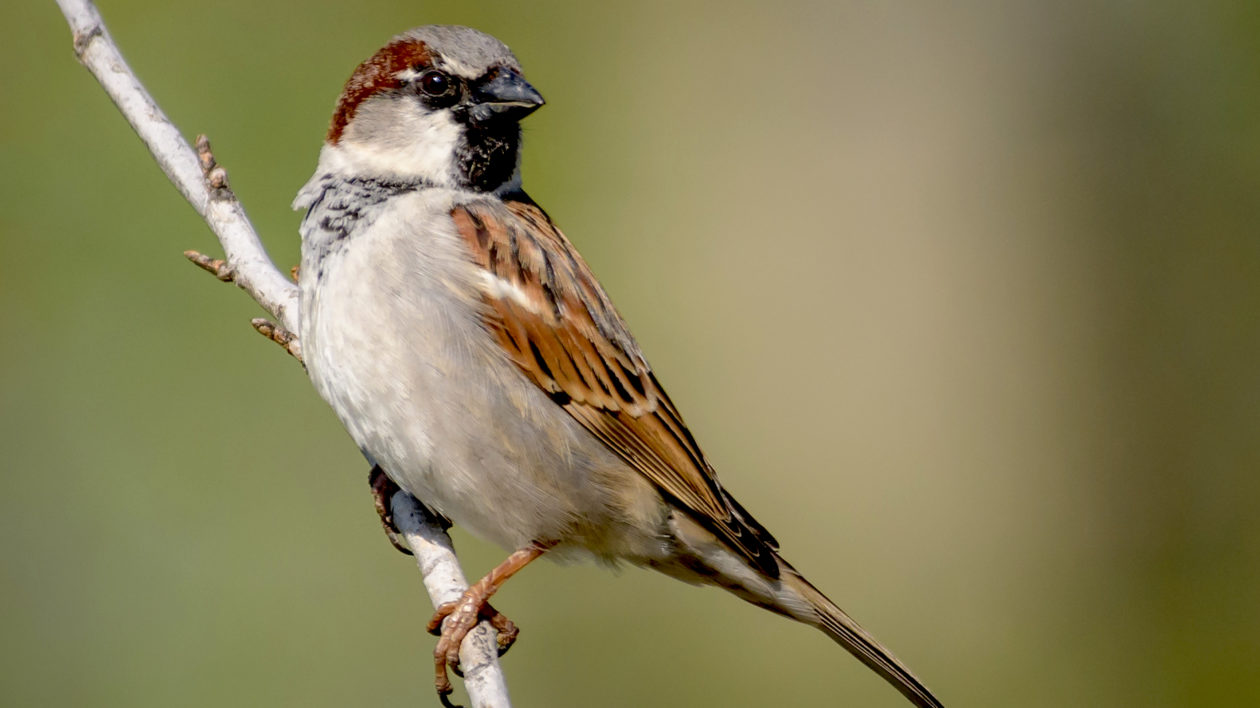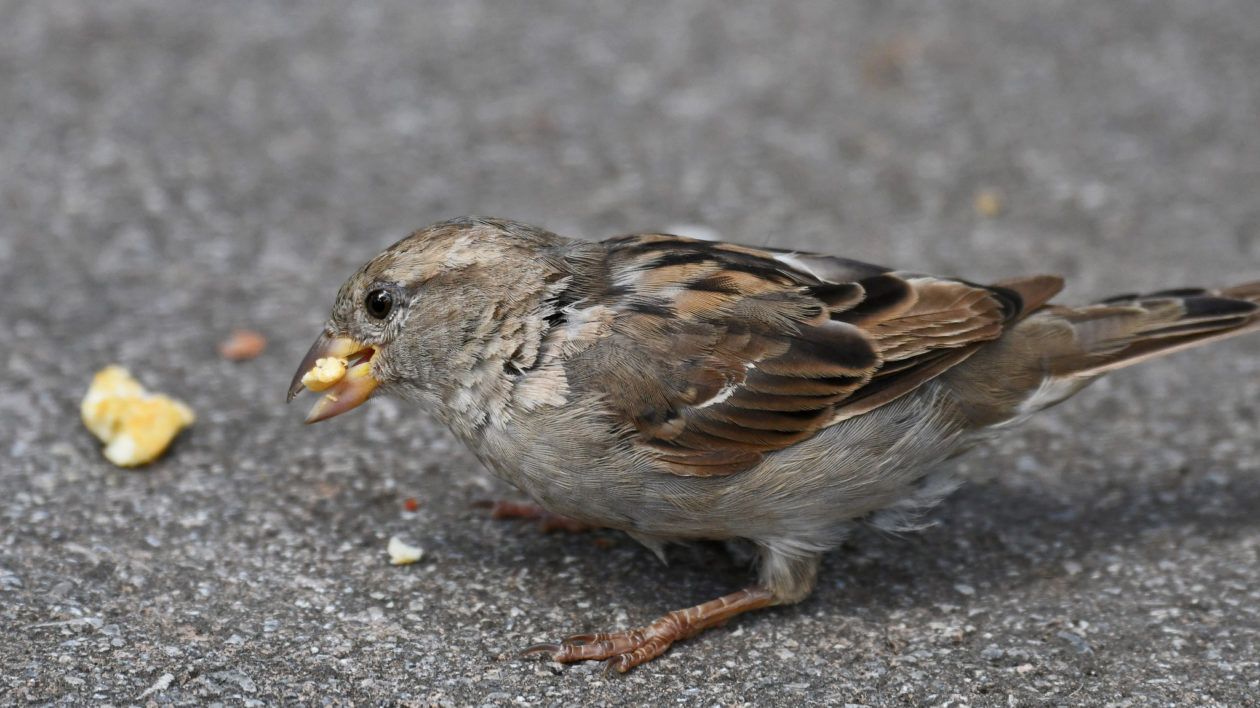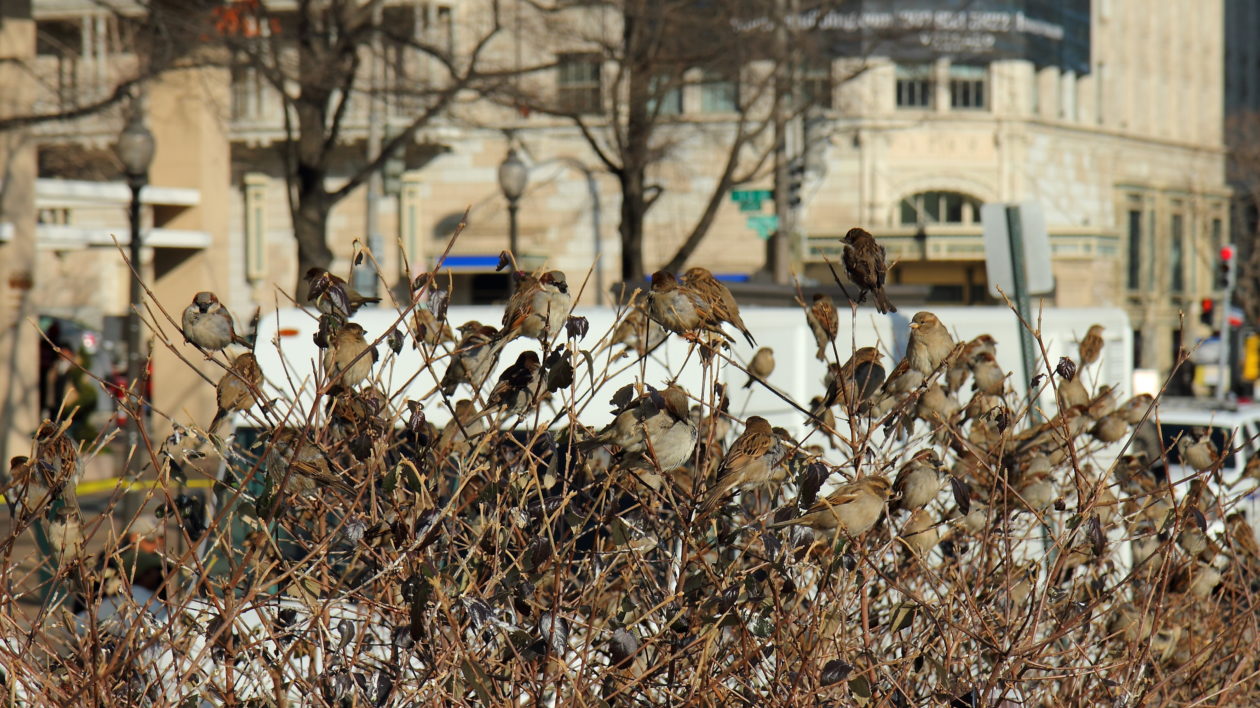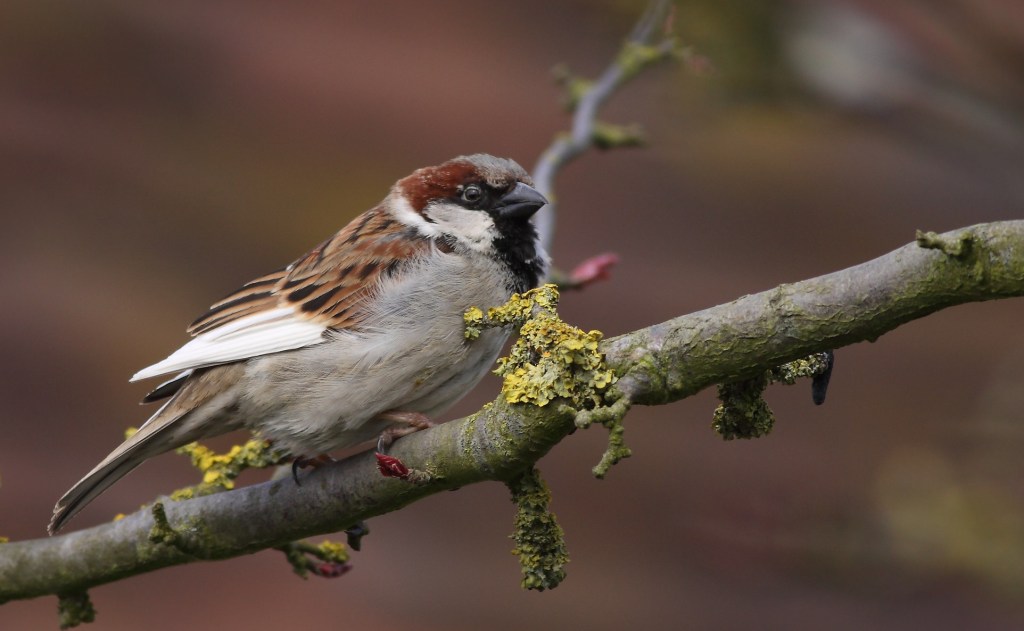I look out my window, and they’re everywhere: hundreds of house sparrows flit around our shrubs, hop around the yard, and steal food from our backyard chickens.
At this time of year, the males puff up and display, making them appear like much larger birds. They cheep incessantly, often drowning out other birdsong.
Given their constant presence, it seems odd to be writing this: House sparrow populations have been declining worldwide, including in their native range.
House sparrows are often considered one of the most adaptable birds, capable of thriving amongst our farms, suburbs and cities. The real story of their spread and decline is a bit more complex, and may have implications for urban conservation.
The Sparrow Fad
The house sparrow (Passer domesticus) is native to Eurasia, but beginning in the mid-1800s, it spread around the globe. Largely due to intentional releases by humans, house sparrows are now found on every continent except Antarctica, as well as many islands. It is the most widespread wild bird on earth.
As with many aspects of conservation history, many of the details of sparrow introductions are poorly documented. The first introduction to North America was to New York City in 1851 or 1852, although the 8 pairs released seemed to fare poorly. However, this set off a wave of introductions throughout the United States.
For a time, some sources refer to a “sparrow fad,” with private individuals breeding birds, and others catching them and releasing them into new areas. Nest boxes were installed in cities to increase sparrow populations. Ornithologists and others raised concerns over the merits of house sparrows, but their arguments proved futile against sparrow enthusiasts releasing cages full of birds.
The reason for many of these reasons was for pest control. For instance, their 1868 introduction to Philadelphia was apparently an effort to control inchworms. As with so many such pest control efforts, the cure proved worse than the disease. They thrive on a variety of foods, including spilled grain and even garbage.
The house sparrow is also an aggressive little bird. It nests in cavities, and pushed out native species like Eastern bluebirds. Backyard birders who erect birdhouses have undoubtedly noticed house sparrows bullying wrens and other native species.
Public sentiment turned quickly against the house sparrow. By the 1880s, just three decades after the first introduction, several U.S. cities paid bounties for the birds. But by then the bird was firmly established – and spreading.

Recent research published in the Proceedings of the Royal Society B found that house sparrows underwent genetic changes, including modified skull development and a gene that helps create the enzyme amylase that helps break down starch. The researchers hypothesized that these changes helped sparrows adapt to human settlements dominated by agricultural fields and livestock. The sparrows, according to the research, diverged from other Old World sparrows around 11,000 years ago, just as agriculture was taking hold in the Middle East.
The house sparrow appears to be a clear winner in the Anthropocene: an adaptable bird capable of thriving equally well on cities and in farms.
But over the past few decades, ornithologists have noted a new trend: house sparrows are in widespread decline. According to the Cornell Lab of Ornithology, house sparrow numbers in North America have declined by 84 percent since 1966. In Philadelphia, the city where the sparrows were introduced to control inchworms, the birds have largely disappeared.
Many birders view this as a good-news story. After all, house sparrows compete with native species and are generally viewed as a pest. However, the bird is experiencing similar declines in many parts of its native habitat, including the United Kingdom and Western Europe.
In England, house sparrow populations have declined by half. The species is listed by the Royal Society for the Protection of Birds as a species of high conservation concern. While the United Kingdom population has recently stabilized, the bird remains of concern to conservationists. European countries now recognize a World Sparrow Day to raise awareness of the plight of this once-abundant species.
What happened?

Sparrow Falling
Theories abound as to why house sparrows have declined. The answer likely lies in a combination of factors, all tied to rapid changes in both cities and farms. House sparrows may be highly adaptable, but that doesn’t mean they can thrive with every modification humans make to the environment.
The first house sparrow decline was actually reported in the 1920s, when automobiles began widely replacing horses. Sparrows feasted on the huge amount of spilled grain found in cities. When that food source was removed, sparrow populations decreased.
The Royal Society for the Protection of Birds and others note that changing agricultural practices likely play a significant role in the current sparrow decline. Once, farms were diverse, with crop fields and livestock barns scattered across the landscape. New, clean, intensified monocultures result in less spilled grain, and less cover around fields. In many parts of the world, other birds associated with farmland are also in decline.
Livestock is more frequently raised in confined operations, sometimes even indoors. All this results in fewer opportunities to feed on grain.
Similarly, city sanitary practices have improved, which may make finding meals more difficult for sparrows.
Research published in the journal Frontiers in Ecology and Evolution found that a combination of poor diet and air pollution induced physical stress on house sparrows, leading to reduced reproductive success.
The widely reported global insect decline may also be a significant factor. Many think of house sparrows as vegetarians, gobbling bird seed and grains. But, as with many birds, they rely on protein-rich insects to feed their young.

Implications for Urban Conservation
There are still 540 million house sparrows flying around the planet, so this bird is not in danger of going extinct. It’s still abundant in many places – including my neighborhood, where a mix of native vegetation, bird feeders and backyard chicken coops provide the diversity of habitat and food sources that enables these birds to thrive.
So why is the house sparrow decline important?
In part, it shows how little we understand urban ecology. Even conservationists often assume that common, adaptable species will be able to adapt to any change. That’s clearly not the case.
All ecosystems change, but human environments often change rapidly. If we’re thinking about protecting biodiversity in cities – and in a world that will have 9 billion people, we have to – we have to think about how changes impact wildlife. Just as modification to a tropical forest affects wildlife, so too do changes in farming practices, changes in city design, even changes in bird feeding habits.
I wouldn’t miss the house sparrow from my neighborhood. It’s an invasive species that competes with native birds. But globally, the sparrow’s decline is a story we should heed, as it may help us better understand how to coexist with nature in the Anthropocene.




I live in a remote place in India Once habitants in all walks of life are almost disappeared now On close observation found the following
Homes for converted to concrete structures from huts of grass and tiles Sparrows built nests behind photo frames in walls , gaps of grass covers over the roof, and wherever they found safe gaps to build nests
They used to get fed from the leftover foods from washed utensils and from paddy and rise during harvesting which have now machanised with tractors and hullers ..Concrete homes made the washables go indoors and they lost the sources
“In Philadelphia, the city where the sparrows were introduced to control inchworms, the birds have largely disappeared.”
I was in Philadelphia in July. I stayed near Rittenhouse Square park. The park bird population was overwhelmingly sparrows! And I am pretty sure they were mostly or all house sparrows. I saw a few American Robins. Then, sparrows, sparrows, and more sparrows. I would like to think that I misidentified some house finches as sparrows, but I doubt it because I didn’t see a single adult male house finch, which are easy to i.d.